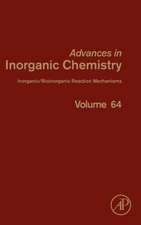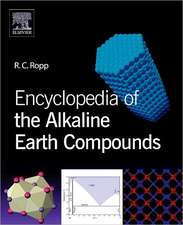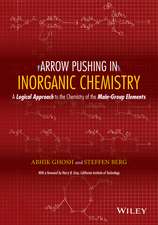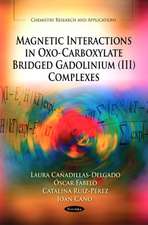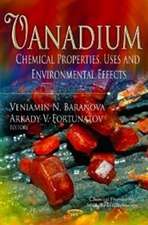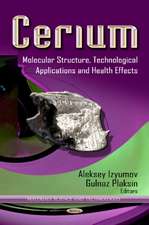Metals and Life
en Limba Engleză Paperback – 31 oct 2009
Metals play a vital role in the metabolism of plants and animals and, increasingly, in medicine. This book provides an introduction to the metals essential to life and ligands of biological importance. It considers the uptake of metals, their transport and ultimately their storage, illustrated in particular with the story of iron in the body. It also considers Na, K and Ca ion channels and biomineralisation and covers the key roles that metals and their complexes play in living systems, for example in respiration and photosynthesis. The last chapter (delivered online) considers metal toxicity and deficiency as well as the role that metals play in medicine, looking at both diagnostics and therapy, and in the forefront of inorganic research.
Preț: 253.22 lei
Nou
Puncte Express: 380
Preț estimativ în valută:
48.45€ • 50.59$ • 40.01£
48.45€ • 50.59$ • 40.01£
Carte disponibilă
Livrare economică 25 martie-08 aprilie
Preluare comenzi: 021 569.72.76
Specificații
ISBN-13: 9781849730594
ISBN-10: 1849730598
Pagini: 226
Ilustrații: colour illustrations, black & white tables, figures
Dimensiuni: 211 x 262 x 14 mm
Greutate: 0.79 kg
Ediția:Edition.
Editura: Royal Society Of Chemistry
ISBN-10: 1849730598
Pagini: 226
Ilustrații: colour illustrations, black & white tables, figures
Dimensiuni: 211 x 262 x 14 mm
Greutate: 0.79 kg
Ediția:Edition.
Editura: Royal Society Of Chemistry
Cuprins
Introduction Ligands and biological significance Metal uptake - increasing the solubility of iron Metal transport Metal storage Biomineralisation The role of metal-containing proteins in biological processes Some key biological processes Additional online material: Metals in medicine
Notă biografică
Eleanor Crabb is a Lecturer in materials chemistry at The Open University and was recently seconded part-time to one of the Centres for Excellence in Teaching and Learning (CETL) awarded to The Open University. Her research interests are in heterogeneous catalysis. She has written on a number of science courses, producing both text based and multimedia materials, including Separation, Purification and Identification, part of the Molecular World Series (a collection of OU undergraduate texts also published by the RSC). Rob Davies is a Senior Lecturer in inorganic chemistry at Imperial College London. His research interests lie in synthetic organometallic and coordination chemistry, especially of the main group metals, and he has published extensively in these areas. He is also the author of a chapter in the Handbook of Chalcogen Chemistry, New Perspectives in Sulfur, Selenium and Tellurium, Cambridge, published by the RSC. Rob Janes is a Staff Tutor at The Open University in Wales. He has co-authored the Elements of the p-block in the Molecular World Series and has produced a CD-ROM-database of chemical demonstrations to accompany the book. Together with Elaine Moore, he was also a co-author of Metal-ligand bonding, another RSC publication. He is a co-presenter of Magic Molecules, a demonstration lecture aimed at schools and the general public. Elaine Moore is Reader in theoretical chemistry at The Open University. Her research interests lie in the field of computational chemistry. She is the author of OU teaching texts in chemistry, physics and astronomy, including Molecular Modelling and Bonding, in the Molecular World Series, and Metal-ligand bonding. Lesley Smart is a Visiting Senior Lecturer in chemistry at The Open University. She has written on many science courses and chaired the production of the Molecular World Series. She is also an author of two books in the series' The Third Dimension and Separation, Purification and Identification. Paul Walton is Professor of Bioinorganic Chemistry at the University of York. His research interests include synthetic models of zinc metalloenzymes, metal sensors and metal complex catalysts for carbon dioxide conversion. He also has strong interests in teaching, having won the Royal Society of Chemistry's Higher Education Award in 2000.
Textul de pe ultima copertă
This teaching text provides an introduction to the fascinating area of bioinorganic chemistry, examining the role that metal ions and their complexes play in the physiology of animals and plants. This topic is an important part of any undergraduate course in inorganic chemistry. The book begins with an introduction to the metals essential to life and the idea that the vast majority of these occur coordinated to biological ligands, such as amino acids in metalloproteins. It then considers how metal ions are acquired by organisms, illustrated, in particular, with the uptake of iron by bacteria and plants, before moving on to discuss how metal ions are transported within an organism, including the use of ion channels and pumps. How organisms store metals is also covered, as well as the mechanisms involved in the growth of teeth and bone in a process known as biomineralisation. The book finishes by looking at the key roles that metals and their complexes play in biological processes, for example in respiration and photosynthesis. A final chapter (delivered online on an associated website - see below) considers metal toxicity and deficiency as well as the role that metals play in medicine, in both diagnosis and therapy. A basic knowledge of inorganic chemistry, especially coordination chemistry is assumed, together with an appreciation of the techniques used to characterise metal complexes and proteins. The material in this book is designed to be used either as part of an undergraduate chemistry programme, or for self-directed study. Learning is facilitated through various key features, including: -in-text questions with answers -full-colour diagrams -revision exercises on the associated website (www.rsc.org/metalsandlife) This book was written as part of the teaching material for the Open University course, S347 Metals and Life. An associated book, Concepts in Transition Metal Chemistry also published by RSC Publishing, provides the necessary background in transition metal and coordination chemistry.
Descriere
An introduction to the metals essential to life and ligands of biological importance including the uptake of metals, their transport and storage.

